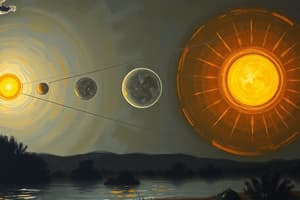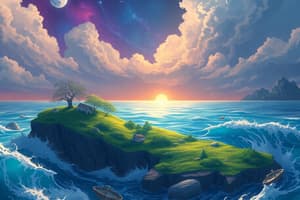Podcast
Questions and Answers
What causes the annual change of seasons?
What causes the annual change of seasons?
What is the declination of the sun?
What is the declination of the sun?
The latitude receiving the vertical rays of the sun.
When does the June solstice occur?
When does the June solstice occur?
On or about June 21.
What is the circle of illumination?
What is the circle of illumination?
Signup and view all the answers
What happens during the September equinox?
What happens during the September equinox?
Signup and view all the answers
What occurs during the December solstice?
What occurs during the December solstice?
Signup and view all the answers
When does the March equinox occur?
When does the March equinox occur?
Signup and view all the answers
What changes occur in patterns of sunlight around the Earth?
What changes occur in patterns of sunlight around the Earth?
Signup and view all the answers
What is the day length like at the equator?
What is the day length like at the equator?
Signup and view all the answers
How does Earth rotate on its axis?
How does Earth rotate on its axis?
Signup and view all the answers
The angle of the sun above the horizon is known as _____
The angle of the sun above the horizon is known as _____
Signup and view all the answers
The formula for Solar Altitude is SA = 90 - _____
The formula for Solar Altitude is SA = 90 - _____
Signup and view all the answers
Study Notes
Seasons and Sun's Position
- Seasonal changes are caused by the Earth's shifting relationship to the sun, impacting day length and sunlight angle.
- The declination of the sun, or subsolar point, is the latitude where sunlight strikes the Earth at a 90-degree angle.
Solstices
- June Solstice: Occurs around June 21; the North Pole is closest to the sun, with vertical rays hitting the Tropic of Cancer (23.5°N).
- December Solstice: Occurs around December 21; the Northern Hemisphere tilts away from the sun, resulting in the shortest day and longest night.
Equinoxes
- September Equinox: Around September 22; the Earth experiences equal day and night; marks the start of autumn in the Northern Hemisphere and spring in the Southern Hemisphere.
- March Equinox: Around March 20; similarly equal day and night across the globe, signaling spring in the Northern Hemisphere and fall in the Southern Hemisphere.
Circle of Illumination
- The great circle dividing daylight from darkness; bisects the equator on the June solstice, creating equal day and night at the equator.
Sunlight Patterns
- Vertical sun rays only strike between the Tropic of Cancer (23.5°N) and Tropic of Capricorn (23.5°S). They migrate seasonally, moving north after the March equinox and south after the June solstice.
Day Length Variations
- Day length remains consistent at the equator with approximately 12 hours of daylight year-round; variations exist in other latitudes due to Earth’s tilt.
Earth's Rotation
- Earth rotates counterclockwise when viewed from the North Pole, completing a full rotation in 24 hours.
Solar Altitude
- Solar altitude is the angle of the sun above the horizon; calculated as SA = 90° - Arc Distance, where Arc Distance refers to the distance between the subsolar point and the observer’s latitude.
Studying That Suits You
Use AI to generate personalized quizzes and flashcards to suit your learning preferences.
Description
Explore the fundamentals of Earth's relationship with the sun in this flashcard quiz. Learn about the causes of seasonal changes and the concept of the sun's declination. Perfect for students studying Earth Science.




